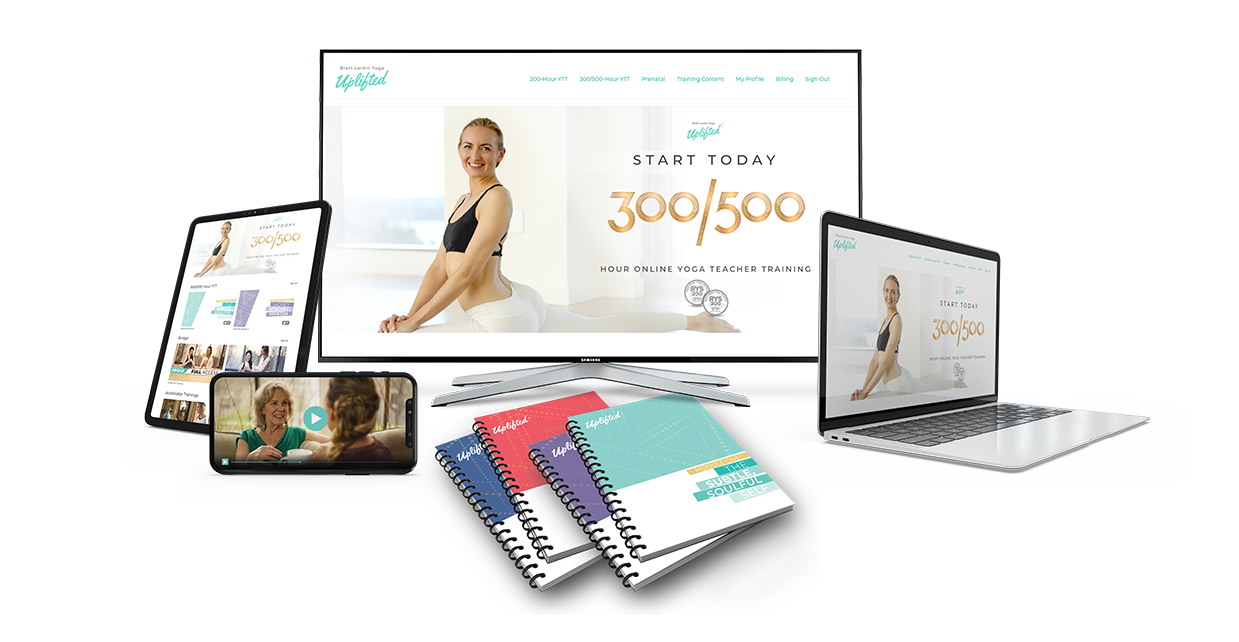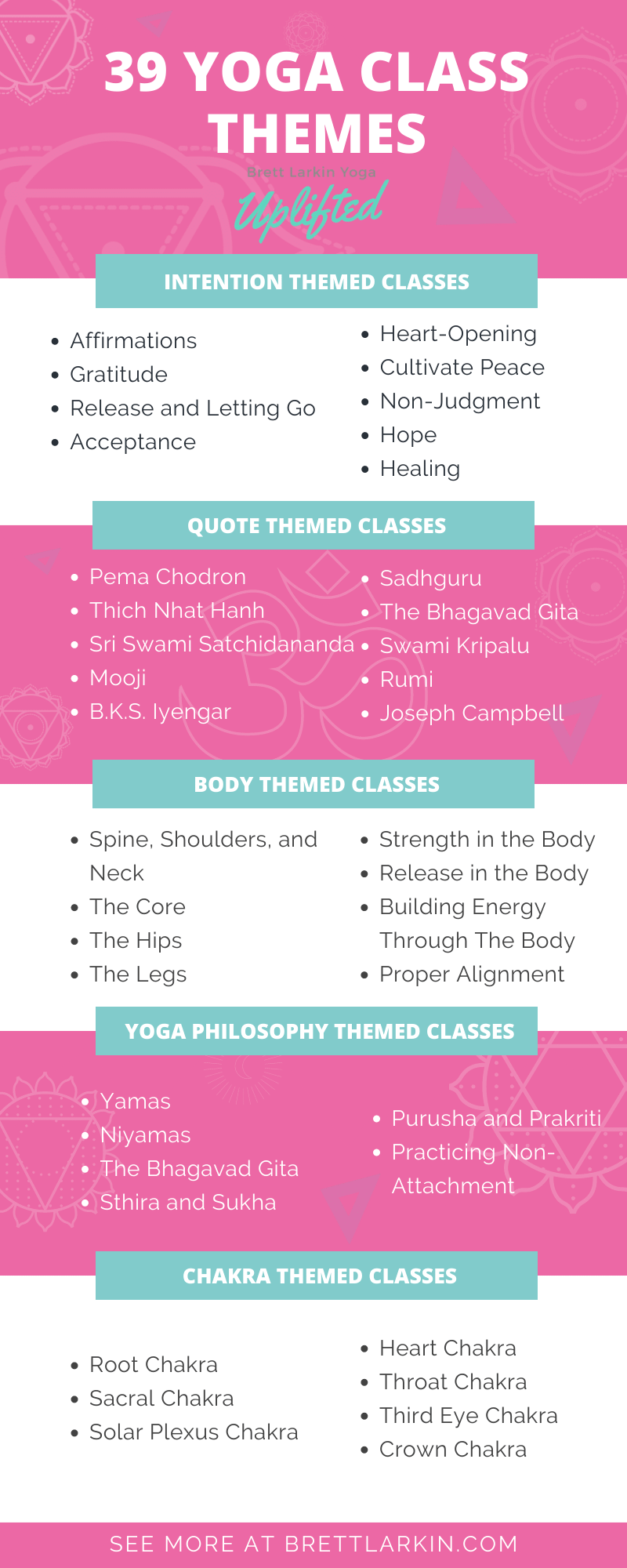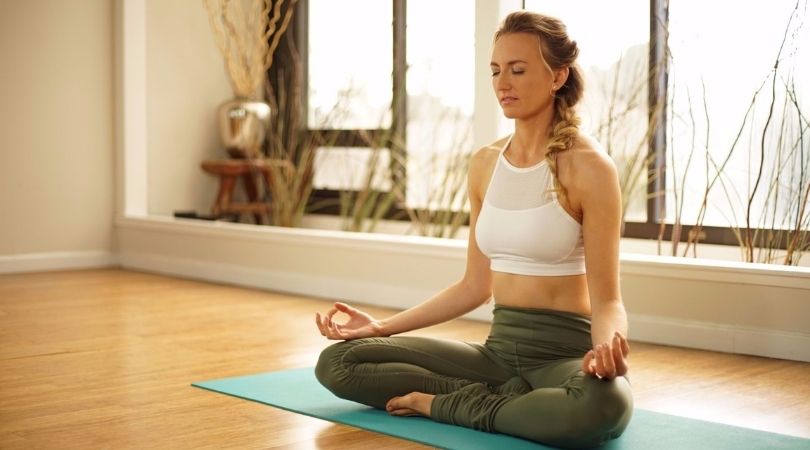Whether you’ve been teaching yoga for years or fresh out of a yoga teacher training course, it is inevitable that at some point in your yoga teaching career you may become stuck in a rut and in need of inspiration.
One of my favorite ways to freshen up my yoga classes and get my creative juices flowing is by incorporating a class theme.
It could be something as simple as weaving an intention or inspirational reading throughout class or creating a sequence themed around a specific area of the body to a more in-depth class theme like a 7-week chakra series.
In this way, being a yoga teacher is a lot like being a tour guide, where you lead your student inward through their yoga practice.
And since so many of my yoga students from my teacher training course ask me about how to incorporate a theme into their yoga sequence, I thought I’d write a blog post about how I do it when I create my own class plan.
While there are infinite possibilities when it comes to yoga class themes, I generally stick to these 5 types of themes.
1. Intention Themed Class
Setting an intention is a really nice way to give your students something to recall or come back to throughout the yoga class. I find it especially powerful because it helps students practice coming back to the present moment, which is at the core of yoga philosophy.
As part of your opening meditation, offer your students a simple intention that will be easy to recall as you move through class. For example, “to invite in softness”.
You can then weave this theme “to invite in softness” throughout your class by choosing cues for each yoga posture that encourages softness.
With this yoga theme, you can remind students to soften places in the body where we habitually hold tension, like the jaw, face, back, neck and shoulders. As you move through each yoga pose, bring awareness back to softening in that pose.
Softening cues work well in active classes as well, like Hatha yoga or Vinyasa yoga, as well as more passive classes, like restorative yoga or Yin yoga.
How To Do It
- With an intention-setting yoga class theme, it helps to move slowly through the postures so that you can allow time and space for the intention to take hold with the student.
- Restorative poses are perfect for this because they don’t require much physical effort, which provides space for the yoga student to go inward and connect with the intention set at the beginning of class.
- A really nice time to offer your students to recall this intention would be in a resting pose like child’s pose (Balasana) or mountain pose (Tadasana). Use this pause to encourage them to use the breath to soften tight places and release tension.
- For more active styles of yoga, like Hatha yoga or Vinyasa yoga, you can hold challenging yoga postures for a little longer than usual and invite students to scan the body for tension to release. In warrior pose, for example, allow students to ground themselves into the yoga mat through strong legs. On the inhale, bring in the intention to invite softness and, on the exhale, release tension.
- With both standing poses and seated poses, use the breath to come back to the intention.
- To close your class and weave it all together, offer your intention one final time and invite them to bring this intention with them beyond their yoga mat and into their day.
Intentions For Yoga Class Theme Examples
- Affirmations
- Gratitude
- Release and Letting Go
- Acceptance
- Heart-Opening
- Cultivate Peace
- Non-Judgment
- Hope
- Healing
2. Inspirational Reading Themed Class
I love incorporating inspirational readings in my yoga classes. Some of my favorite readings are from Pema Chodron, Thich Nhat Hahn, and Sri Swami Satchidananda. Their writings are compassionate, relatable, and concise. I have also found many lovely readings and poems online by various authors.
When using a reading for my class theme, I introduce it at the beginning of class. You can choose whether you would like to do this at the very start of class or as part of your opening guided meditation.
You could even share your reading throughout the class as students hold poses for a few breaths. (I recommend saving your longer readings for seated poses or restorative poses)
How To Do It
- Depending on the reading you choose, you can plan your sequence based on the overall theme. For example, with a theme/reading of compassion, you may choose poses that promote opening both the front and back gate of the heart. Gentle backbends and forward folds are great poses to choose for this theme.
- As you move through your yoga sequence, and in addition to your alignment cues, you can also weave ideas or thoughts from your reading into your teaching. Remind them to be compassionate to themselves within the pose and to trust the process of their yoga practice.
- When it is time for Savasana, you can recall the theme and offer them to use their time in Savasana to reflect upon or use the theme as something for the mind to lean on if that would serve them.
- To close practice, you could read the opening reading again or write your own closing to share along the same theme (I love writing my own closings). It would also be really nice to incorporate a pranayama breathing exercise or guided meditation inline with your theme if time allows.
Inspirational Authors Class Theme Examples
- Pema Chodron
- Thich Nhat Hanh
- Sri Swami Satchidananda
- Mooji
- Sadhguru
- The Bhagavad Gita
- Swami Kripalu
- Rumi
- Joseph Campbell
- B.K.S. Iyengar
3. Area of the Body Themed Class
You can really get creative with this yoga theme as you can choose any part of the body, from a very specific area (the heart center) to larger areas (core/upper body). You can incorporate an intention specific to the area you are working on or poem that correlates with it.
For example, if you were doing a heart-opening theme, you may choose a reading about opening, releasing or something specific to the heart. You could even weave in the chakra that correlates to the area of the body your class is themed around.
Get creative, your students will appreciate the thought and creativity!
When creating your sequence you want to take care that the poses you choose correlate to your theme. Of course, you will also need to incorporate thoughtful warm-ups and counterposes as well, but the core poses should be inline with your theme.
How To Do It
- If you are weaving through an intention or chakra associated with the area of the body, then recall the intention or share your teachings about the chakra as you move through class.
- As part of the closing sequence of your area of the body themed class, it is nice to incorporate one or two restorative poses specific to your theme.
- When it is time for Savasana, you can offer variations and props to support the area of the body you chose for your theme. For example, if you were working with the legs, particularly the hamstrings, a bolster under the knees would help to support and release the muscles allowing for deeper relaxation.
- As you close the class, weave the theme, intention, reading, or chakra together in one final closing statement.
Area Of The Body Class Theme Examples
- Spine, Shoulders, and Neck
- The Core
- The Hips
- The Legs
- Proper Alignment
- Strength in the Body
- Release in the Body
- Building Energy Through The Body
Fall in love with my 300-Hour teacher training or …
4. Yoga Philosophy Themed Class
The Yoga Sutra is a treasure trove of themes! With so many translations and interpretations available, the possibilities are endless for Yoga Sutra inspired themes. You could choose an individual sutra, a passage that resonates with you, or one of the eight limbs.
Or, it could be something like a single concept like sthira and sukha.
For example, if you were using Sthira (foundation or strength) and Sukha (sweetness or ease), you could introduce the concept at the beginning of class. In your opening guided meditation, invite students to notice the structure and foundation of their seat and ease or softness in the breath.
How To Do It
- As you move through your sequence, choose cues that encourage a balance of sthira and sukha within each posture. Hatha style poses would be great to use as part of this theme to really invite your students to settle into each yoga posture and feel the balance of sthira and sukha.
- When it comes time for Savasana, you can invite them to find the balance by releasing and softening into the foundation of the earth beneath them.
- As you close your practice, recall the Sutra theme you chose and remind your students that the work that they did translates beyond their practice and into their lives.
Yoga Philosophy Theme Examples
5. Chakra Themed Class
I love teaching chakra themed classes so much that I’ve even created an entire chakra challenge! I especially love working with chakras as a theme because it can develop into a multipurpose theme, targeting both areas of the physical body as well as the spiritual body.
You can choose an individual chakra or multiple chakras to create your theme. For example, your class could be themed on the lower three chakras or upper three chakras. Focusing on multiple chakras at a time allows yoga practitioners to explore how they relate to and affect one another.
You could even create a 7-week series, working with one chakra each week.
How To Do It
- There are so many great references available on the chakras, but my very favorite is Anodea Judith’s Chakra Yoga. This book goes into great detail about each chakra, how the chakras relate to one another, how the chakra system works and provides yoga poses and sequences for each chakra. Each pose is broken down with detailed alignment, benefits, and contraindications, along with a beautiful color photo.
- Chakra Yoga is an all-in-one reference for sequencing, meditations, language to use as part of your theme and practices to help your students experience and work with subtle energy.
Chakra Yoga Theme Examples
- Root Chakra (Muladhara) Class Theme –Focusing on grounding and connecting with Earth energy
- Sacral Chakra (Svadisthana) Class Theme – Focusing on creativity and upward moving energy
- Solar Plexus Chakra (Manipura) Class Theme – Focusing on building fire and directing the energy outward into productive and meaningful actions
- Heart Chakra (Anahata) Class Theme – Focusing on expanding the heart center to both receive and give love
- Throat Chakra (Vishuddha) Class Theme – Focusing on opening up our ability to communicate with the Divine and receiving her message
- Third Eye Chakra (Ajna) Class Theme – Focusing on developing laser vision for the Truth in every moment
- Crown Chakra (Sahasrara) Class Theme – Focusing on humbly connecting with God through your yoga practice
Next Steps:
- Explore my Yoga Teacher Resource knowledge hub for more tips about how to grow your yoga business.
- Download my sequences for a jumpstart on your upcoming yoga classes!
- For more detailed tips, processes, and worksheets to supercharge your yoga business, download my yoga business launchpad course!

Sneak Peak into My 300-Hour YTT - FREE Videos, Info Session, Bonuses!

YOU MIGHT ALSO LIKE
- How To Create Mindful Somatic Yoga Sequences Your Students Will Love
- What Is Mindset Coaching? A Complete Breakdown
- 5 Affordable Yoga Teacher Insurance Plans (Updated 2024)
- How To Make A Life Coaching Intake Form
- 7 Steps To Start A Life Coaching Business
- What Is A Self Love Coach? And How To Become One
- Self-Coaching: How To Become Your Own Life Coach
- Types Of Life Coaches: How To Choose Your Life Coaching Niche
- 20 Awesome Ways To Make Money As A Yoga Instructor
- Life Coach Marketing: A Comprehensive Guide For Long-Term Growth
- How To Get Clients For Life Coaching
- Are Life Coaches Worth It? Take This Self-Assessment To Find Out.
- How Much Does A Life Coach Make? Around $5k+ A Month
- Yoga Cues 101: Everything You Need To Teach Yoga
- How Much Do Yoga Teachers Make? (And How To Earn More)
- Life Coaching Skills: Are You Meant To Be A Life Coach?
- How To Incorporate Somatic Coaching Into Your Yoga Practice
- How to Easily Modify 6 Common Yoga Poses [+VIDEO]
- Try This 30-Minute Yoga Nidra Script for Deep Sleep and Relaxation [+ Video]
- 8 Best Yoga Podcasts For Yogic Business And Living
- How To Become A Life Coach (For Yoga Teachers)
- How To Use Social Media To Grow Your Yoga Business
- How To Find Your Yoga Niche (And Make $5K/mo)
- How To Make $5k Per Month As A Yoga Teacher
- How to Plan a Yoga Retreat That Earns 6 Figures
- Which Uplifted online yoga training is right for you?
- Creating Inclusive Yoga Spaces: Here’s What To Avoid Saying
- The Best Yoga Business Coaches to Skyrocket Your Income
- Traditional Yoga Class Plan Template (Tips for Yoga Sequencing)
- Best Blog Platform for Yoga Teachers
- Managing Cash Flow and Profit In Your Yoga Business
- The Top 5 Biggest Fears of New Yoga Teachers
- The Best Yoga Playlists For Yoga Teachers
- Why You Need A Yoga Intake Form (FREE download)
- How to Make a Logo for Your Yoga Business (No Design Skills Needed)
- This Cold Email Will Help You Land a Corporate Teaching Job
- This Cold Email Will Help You Land a Studio Teaching Job
- 9 Yoga Modifications for Pregnancy and How to Teach Them
- Our Expert Advice On How and Why To Teach Corporate Yoga
- How to Upgrade Your Yoga Alliance Certification Designation to 300 / 500 RYT
- How to Register Your YTT Certificate With Yoga Alliance (With Photos)
- How to Get Traffic to Your Yoga Website With SEO
- How to Update Your Yoga Alliance Teacher Profile Step-by-Step
- 6 Best Online Course Platforms For Yoga Teachers (Ranked)
- How To Make An Instagram Business Account As A Yoga Teacher
- 12 Actionable Tips For New Yoga Teachers Who Are Scared To Teach
- How To Prioritize Student Feedback On Zoom
- How To Teach Yoga On Zoom With Two Devices In 6 Easy Steps
- What Is Trauma Informed Yoga And Should I Get Certified?
- 10 Things You Must Do After Your Yoga Teacher Training
- 13 Types of Yoga Teacher Tax Deductions (And Other Tax Tips)
- My Exact Tech Tools For My Million Dollar Online Yoga Platform
- 10 Best FREE Facebook Groups For Yoga Teachers
- How To Log Yoga Alliance Continuing Education Hours
- The Only 7 Yoga Alliance Membership Benefits (Some Are Free)













